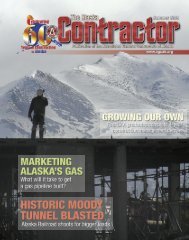The Alaska Contractor: Special 60th Anniversary Issue
The Alaska Contractor: Special 60th Anniversary Issue
The Alaska Contractor: Special 60th Anniversary Issue
Create successful ePaper yourself
Turn your PDF publications into a flip-book with our unique Google optimized e-Paper software.
PH O TO: CO U R T E SY O F YU KO N EQ U I P M E N T<br />
Glen Chambers in Anchorage store after last addition.<br />
mining operation in <strong>Alaska</strong>.<br />
“Fiat-Alice Chalmers … they decided to close things out<br />
and we just elected to mutually go our separate ways. It was<br />
right after the pipeline was done. <strong>The</strong>y decided we should<br />
part company and we were most happy to. We came out real<br />
good on that.<br />
“By then we were taking on the Case line of equipment,<br />
which is smaller dozers. Some of the stuff we called the<br />
homesteader’s special because they’d use it to clean out and<br />
get into their homesteads, building the little roads.”<br />
Turning a bit nostalgic, Chambers softly continues, “John<br />
Deere and Caterpillar are about the only old two tractors<br />
still made in the U.S., and even Caterpillar engines are built<br />
in Japan. So much of this stuff comes from Japan now.”<br />
Equipment changes<br />
“Everything was cable when we fi rst started,” Chambers<br />
said. By cable he means that things like drag lines were operated<br />
by a series of cables reeling and unreeling as the bucket<br />
is fi lled, raised, emptied and returned for another scoop.<br />
“Alice Chalmers was one of the fi rst to come in with hydraulics<br />
and that just changes the picture completely. <strong>The</strong>re<br />
was no more cable.<br />
“At one time we had a line of cable we sold … everybody<br />
did … and we fi nally just went out of the cable business<br />
New Case 475 Cable Trencher.<br />
entirely. <strong>The</strong> manufacturer came up and wanted to know<br />
why we weren’t taking cable—this was just right after the<br />
earthquake.<br />
“We were sitting up in the Petroleum Club on top of the<br />
Hilton,” Chambers continued.<br />
(Ed. Note: <strong>The</strong> Petroleum Club in those days looked out over<br />
the Ship Creek area which always had all sorts of heavy equipment<br />
in motion relating to the harbor and the <strong>Alaska</strong> Railroad.)<br />
“<strong>The</strong> only piece of equipment out there with cable was<br />
the crane. I said that’s why we gave it up; nobody’s using it<br />
anymore.<br />
“That [hydraulics] was probably the biggest change, and<br />
now they’re getting electronically controlled. I’ve been out<br />
[retired] 15 years, so some of that’s getting away from me.”<br />
<strong>Alaska</strong>’s big projects<br />
While Yukon Equipment has been involved in virtually<br />
every large project in <strong>Alaska</strong> over the years, it’s not always<br />
in ways you might fi rst think. For example, when the Parks<br />
Highway was constructed between Fairbanks and Anchorage<br />
in the late 1960s and early 1970s, about all Chambers<br />
can recall providing are some scrapers and tractors to the<br />
joint venture between GHEMM Co. and Rivers Construction,<br />
which worked on major parts of the road.<br />
For the trans-<strong>Alaska</strong> oil pipeline, Yukon Equipment was<br />
pretty much left out in the cold as far as tractors were concerned—Caterpillar<br />
had more or less an exclusive contract<br />
to provide the heavy equipment.<br />
But, about that time, “we had taken on the DuPont line of<br />
explosives,” Chambers said. “We did the compressors at the<br />
tank farm in Valdez and cut a nice deal on dynamite for the<br />
pipeline. Thousands of pounds of powder on that. That was<br />
our big thing … lots and lots and lots of dynamite and some<br />
of this air stuff.<br />
“We did a better job of taking care of the customers nonpipeline<br />
related. It was a good venture.”<br />
Partly as a result of the pipeline, Anchorage itself grew<br />
at a rapid rate, particularly east of Gamble Street and south<br />
of 15th.<br />
14 <strong>The</strong> <strong>Alaska</strong> conTrAcTor <strong>60th</strong> <strong>Anniversary</strong> <strong>Issue</strong> 1948–2008<br />
PH O TO: CO U R T E SY O F YU KO N EQ U I P M E N T

















